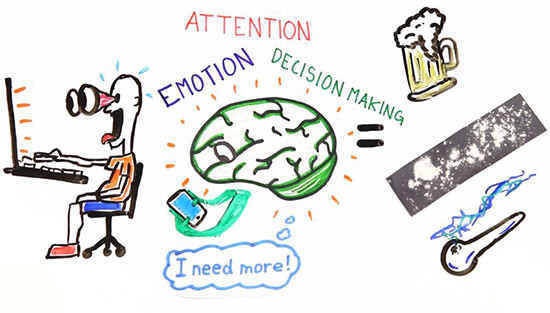Beware the Threat of Attention Engineering | |
Beware the Threat of Attention EngineeringColumnist LaBrot is hot on the trail of a design renaissance to replace, or at least compete with todayâs social media dominance that hacks us where it hurts: the limbic brain.
Didnât social media start off so wonderfully? Reconnecting with old friends, letting the world know about wonderful projects`, connecting people from all over the world, sharing ideas, making friends, publishing creative work, crowd-sourcing problems, starting businesses? Fabulous!
What happened? Why does it feel like itâs leaching out our souls now? |
A LITTLE HISTORY
J.Z. Conger, writing for OTH.com explains, âThe oldâ internet was a beautiful thing; the lack of ads and information collection made surfing the web easy and stress-freeâŠ. However, marketers and businesses soon realized that selling ad space and user information could significantly increase profits, and modern social media sites like Myspace and Facebook followed suit. The mid-to-late 2000s and 2010s saw enormous increases in ad production and the selling of user information.
Today, we are dealing with a new marketing strategy: Attention Engineering. I define it as âusing psychological techniques, such as creating dopamine feedback loops that fuel primal emotions to retain platform-user attention as long as possible to maximize advertising revenue and information collection.â
| THE ATTENTION ECONOMY
Currently, we are facing the rise of an internet that is formed by the demands of advertisers and data collectors who sell your information for a lot of money. These technicians, aka attention engineers, are designing products like smart phones and social media platforms to be as addictive as possible. Many of their ideas are based on research gleaned in Las Vegas among gamblers.
âFacebook, Twitter and other companies use methods similar to the gambling industry to keep users on their websites. In the online economy, revenue is a function of continuous consumer attention that is measured in clicks and time spent,â says Natasha SchĂŒll, author of âAddiction by Design.â
In other words, keep the user online on our site as long and often as possible.
Human beings need social approval. We care what others think of us. Nir Eyal, author of âHooked: How to Build Habit Forming Products,â writes, âWeâre meant to be part of a tribe, so our brains seek out rewards that make us feel accepted, important, attractive, and included. Itâs no wonder that the use of social media has exploded over the past few years. Facebook and Twitter, to name just two of the most popular examples, provide well over a billion people with powerful social rewards on a variable schedule.â
A variable schedule creates addictive behavior. In Operant Behaviorist B.F. Skinnerâs lab, mice were given treats on a variable schedule, i.e., variables being time given and size of treat. Mice on the variable schedule started pressing the treat release lever compulsively, unlike the mice given regularly timed and measured treats.
Modern tech products like smart phones and social media platforms have alert systems that act like treatsâŠthe user doesnât know when or what he/she is going to get, so they âhave to look.â If they get a âlike,â there is a dopamine release into the brain, a measurable 400% spike of the short-acting, pleasure-inducing chemical. Hence, you have people checking their sites compulsivelyâŠaddictively.
See? Itâs not completely your faultâŠyouâve been hacked!  | ANGER AS MANAGEMENT
In the race for attention, outrage works brilliantly for social media. Content that stimulates emotion in the limbic system of the brain causes an emotional response that is reactive, like âfight or flight,â rage, fear, panic, or feelings of pleasure like from sex or eating. These are all feelings to do with survival. Reactions to this kind of stimulus bypass the cerebral cortex, the rational, thinking part of the brain.
It is well documented that outrage gets more attention than calmer posts. Before people think, they are sharing, âCan you believeâŠ?â Knowing so much about you from data collection, enables companies to send you targeted posts guaranteed to enrage you and stimulate you to respond then check back to see how people are reacting to you, thereby engaging your time on their platforms.
Ask yourself how many times have you had to check yourself before posting an angry, fearful, panicky post? You know you donât want to engage, but you canât help yourself. Bam! Itâs on!
Donât blame yourself too much. The devil made you do it.
Conger writes, âSocial media and video services are not the only manipulators of attention engineering. The news is jumping on the same bandwagon. Most media sources have become riddled with biased, emotional, addictive coverage that elates or enrages its audience. It is easy to imagine the future of attention engineering. Any digitized screen that can post content is able to abuse human psychology.
Attention engineering is probably the most effective scam of this century. It robs people of quality time, quality information, and quality thought, and it is nearly impossible to resist. These methods attack our psyche at the most primitive levels.â  | HACKING THE HUMAN SOUL
We are living in a kind of Truman Show. In a control room, a few people are shaping the thoughts and feelings of billions of people. Itâs a global phenomenon. Because of the business model of advertising, a client can walk into that media control room and pay to schedule their thoughts into the minds of users. It can be about products or ideas. It is profitable, neuroscientific manipulation. Bad actors can manipulate large swathes of people with little rewards like hearts, thumbs up and emojis, giving us short signals (short posts) that we conflate with value and truth. According to Tristan Harris, the conscience of Silicon Valley, âItâs changing our conversations, democracy and ability to have the conversations and relationships we want to have.â | WHAT TO DO?
Harris, who was a design ethicist for Facebook and a number of other rogue âex-platsâ (people who worked for social media companies) are speaking out. Itâs interesting that they are in their thirties now, the last group to have experienced life pre-social media dominance.
First, Harris says, we must acknowledge we are persuadable and consciously understand we are being manipulated. Second, people in the control rooms, the attention engineers, have to be accountable. Third, we need a design renaissance which, I can tell you, is being worked on at a furious pace. Iâll address that in another article.
Let me assure you, the open-source community, the people of conscience from within the tech industry, thinkers like Daniel Schmachtenberger from the âWar on Sensemakingâ and lots of entrepreneurs are working on this. And.âŠ
âŠYou, too, can do something: Hold on to your humanity.
Vamos a ver!
| | | | | | | | | | |
|
|
|
|
|
















